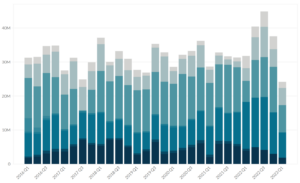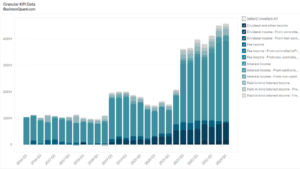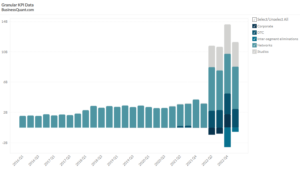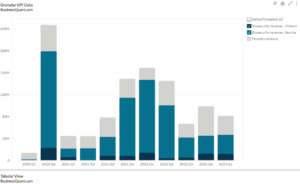
Frontier Communications: Broadband Subscriber Adds
Exclusive Data
You need the Pro Plan to access KPI data
- Full access to the platform
- KPI data & segment financials on US stocks
- Financial data on thousands of stocks
- Download data in xlsx and csv formats
Pro Plan
$49 per month*
60% discount ends in:
.
About
More information
Subscribe to Pro or Enterprise plans to unlock this feature.
Contact the Analyst
Subscribe to Pro or Enterprise plans to unlock this feature.
Become a smarter investor today.
Access KPIs & Segment Financials on US stocks
This interactive statistic highlights Frontier Communications’ Broadband Subscriber adds, reported from Q1 2017 onwards.
Frontier Communication, originally based in Minneapolis, is a telecom company that primarily focussed on serving rural and smaller communities. The company expanded to serve the metropolitan cities featuring its broadband internet, computer tech support and digital television service across 29 states of U.S.
Frontier Communications primarily deals in three types of broadband, varying from type and purpose – Commercial, Consumer Copper, and Consumer Fiber broadbands. The company bifurcated its consumers as residential and business consumers.
- Commercial (Wholesale) Broadbands:
Commercial broadband connections are primarily offered to businesses ranging from small to large scale for competitive internet access with extremely high-speed to meet the demands of customers and caters wholesale customers who will provide local services across remote localities.
Q2 FY 2017 saw a dramatic loss of commercial broadband consumers, which accounts for ten times more than Q1 of the same year, because of which commercial revenue came down by 6.4% to $982 million when compared with Q1. Though the commercial revenue, for the year 2018, dropped to $962 million, but Q2 witnessed an addition of 16,000 users. The sequential decline of commercial broadband users was seen in the year 2019.
- Consumer Copper Broadbands:
These broadband uses typically twisted copper wires over the telephone lines to offer internet services, which costs quite low when compared with new fiber broadbands.
Q2 FY 2017 faced the worse consequences of happenings in Q1; the result dropped consumer revenue to $1.12 from $1.16 billion in Q1. The root for the same was accelerated deactivations because of non-payment. Speeds are usually less in copper broadbands compared to fiber ones. The company focussed on the expansion of speeds via copper broadbands and reduction of churns, but still, 2018 faced a loss of 47,000 consumers. Till Q3, the reduction in consumer count is in leaps despite a consumer revenue of $3.5 billion.
- Consumer Fiber Broadbands:
With a growth over 75% in the market, this corrosion-free fiber wired broadbands speeds up to 500 MBPS by early 2020 with symmetric download and upload speeds.
Frontier’s FY2017 went into stabilizing the CTF markets to improve the consumer churn as consumer DSL has impacted the legacy market. Although, in spite of their management’s efforts to invigorate growth, Q2 faced a loss of 44,000 broadband consumers. The company introduced new Gigabyte service its FiOS and other fiber markets, offering the fastest residential broadband service in the market, leading to a jaw-dropping reduction in consumer churn. Though the consumer churn increased to 2.24% because of losses in consumer copper broadband, Q3 FY 2019 faced the lowest reduction of all time of 1,000 consumers.
Did you find Frontier Communications’ broadband subscriber adds statistic interesting?
Get access to more such granular datasets by registering for Free.
More data on US Stocks

Our Plans
Always know what you’ll pay. No hidden costs or surprises.
- Annual
- Monthly
60% discount till April 30
Pro
For serious investing
-
Company KPI data Access segment financials, non-GAAP metrics and KPI data from presentations and filings. Examples include financials by segment / region / product category, AT&T's broadband subscriber trends, Tesla's deliveries by model and lots more.
-
Stock research tools Features include : stock screener, stock comparison, industry financials, stock warnings, advanced charting tools, timeseries tables, scatter charts, financial statements, stock reports, SEC filings, stock ratings, institutional and insider ownership data. There are 200+ financial items and ratios on thousands of US stocks.
-
Industry data & tools Access premium operating data on 40+ industries. Examples include market share, smartphone shipments by vendor, subscribers by wireless carrier, historical gold production. There are 20,000+ such statistics.
Enterprise
For tailored workflows
-
All of Pro plan Get unfettered access to all our dashboards and dossiers.
-
Custom built features Get tailored dashboards built specially for you , based on your set of requirements, to simplify your research workflow.
-
Admin billing Back-end documentation support and multi-seat licensing.
* Billed annually, local taxes extra.
60% discount on Annual plan
Pro
For serious investing
-
Company KPI data Access segment financials, non-GAAP metrics and KPI data from presentations and filings. Examples include financials by segment / region / product category, AT&T's broadband subscriber trends, Tesla's deliveries by model and lots more.
-
Stock research tools Features include : stock screener, stock comparison, industry financials, stock warnings, advanced charting tools, timeseries tables, scatter charts, financial statements, stock reports, SEC filings, stock ratings, institutional and insider ownership data. There are 200+ financial items and ratios on thousands of US stocks.
-
Industry data & tools Access premium operating data on 40+ industries. Examples include market share, smartphone shipments by vendor, subscribers by wireless carrier, historical gold production. There are 20,000+ such statistics.
Enterprise
For tailored workflows
-
All of Pro plan Get unfettered access to all our features.
-
Custom built features Get tailored dashboards built specially for you , based on your set of requirements, to simplify your research workflow.
-
Admin billing Back-end documentation support and multi-seat licensing.
* Local taxes extra.






